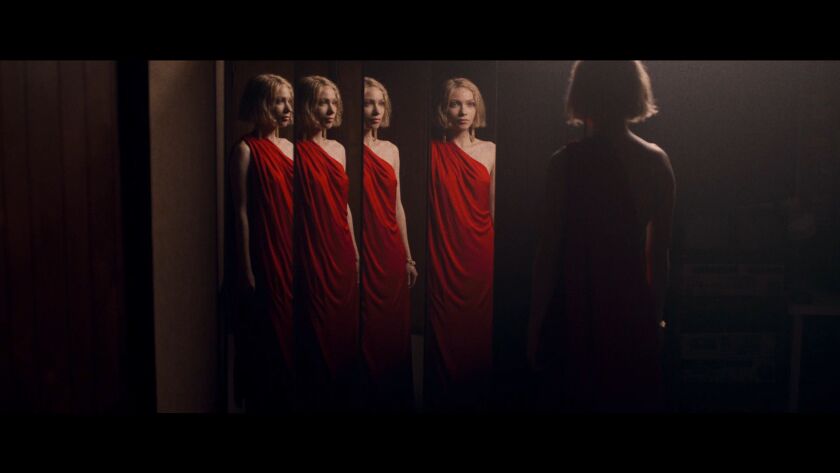TV interviewer: “If you were at a dinner party and you could have one person on your left and one person on your right, who would they be?”
Andy Warhol: “Halston and Elizabeth Taylor.”
Roy Halston Frowick grew up in Iowa and Indiana, attended the School of the Art Institute and began his career in Chicago, opening his first shop on Michigan Avenue in 1957.
By the time he arrived in New York, he was simply “Halston,” and it was as if the boy from Des Moines never existed.
And that’s where Frederic Tcheng’s “Halston” begins — with the handsome, charming, ambitious, superbly talented designer just beginning to make his mark on the fashion world.
This is a curious documentary, with a shifting personality. At times it’s presented as a film noir “mystery,” with an actress portraying an enigmatic figure lurking about Halston’s archives, delivering narration as if she’s in a Dashiell Hammett adaptation.
“They bought his name, sold off his life’s work for pennies on the dollar, forced him out of his own home,” says the femme fatale, played by Tavi Gevinson, the 23-year-old writer-editor-actress-activist-influencer from Oak Park who has been in the public eye ever since she started the “Style Rookie” fashion blog when she was 12.
“Who am I?” says the fictional detective played by Gevinson. “Just somebody working the archives. Nobody important for our purposes …”
Um, OK … but then the conceit is dropped for long stretches, in favor of a traditional documentary chronicling Halston’s spectacular rise to fashion design superstardom, his famous friendships, his mercurial ways, his on-and-off romance with the Venezuelan artist Victor Hugo, his clashes with rivals and corporate bosses, and his lasting impact on the popular culture.
“[When you put on his clothes], they danced with you,” says Liza Minnelli, a Halston favorite.
For those of us not particularly well-versed in 20th century fashion history (he writes, while wearing his daily uniform of jeans and hoodie), “Halston” is filled with fascinating revelations, e.g., when Jackie Kennedy wore Halston’s pillbox cloth hat for the 1961 presidential inauguration, it was so windy, she reached up to steady the hat and put a dent in it — and when the design was copied, the dent was included, as if it had been a part of the original design.
Halston achieved great success working for Bergdorf Goodman but didn’t exactly fit the corporate mold. (In an old clip, Andrew Goodman says, “Roy Halston Frowick is a strange character, quite fussy and he was always very demanding, every little detail. All sorts of small petty things too.”)
By the late 1960s, Halston had set up his own shop and was becoming a sensation. Marisa Berenson and other former Halston models recall working with the brilliant but demanding designer, who was quickly becoming a fixture on the social scene and on the television talk show circuit.
Oh, and now it’s time for another staged scene with our film noir heroine, who says, “Halston never looked back. Today and tomorrow were all that mattered.”
These scenes are kind of interesting, mostly because they’re odd and not really necessary — though I have to say, Gevinson gives a good performance in the brief interludes.
Even as Halston was partying with Andy Warhol and Liza and Elizabeth Taylor and Bianca Jagger at Studio 54 and creating groundbreaking fashion designs, he was expanding his line to include perfumes and luggage and purses and menswear. He even signed a deal with J.C. Penney at time when most high-end designers wouldn’t even think of licensing their work to chain retail stores.
As our heroine alluded to at the beginning of the documentary, Halston was eventually forced out of his own company, but the downfall was mostly of his own making. He was spending thousands on a drug habit, showing up for work at 4 p.m., becoming ever more demanding with his staff — at one point demanding they wear nothing but black, so they’d be background for his creations.
“It was all a set. WE were a set,” says a former staffer.
There are some lighter and warm moments, as when the director Joel Schumacher reminisces about some wild times when he and Halston were young, and when Halston’s niece talks about helping him organize a family reunion in Montauk in the late 1980s, just a couple of years before Halston died at 57 from the AIDS-defining illness Kaposi’s sarcoma.
Unusual framing device aside, “Halston” is on balance a solid and affectionate tribute to an American original.






